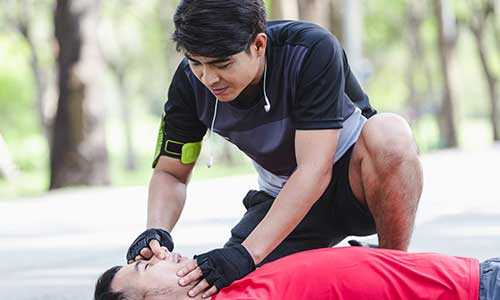First Aid 101 – 5 Essential Skills Everyone Should Know

Imagine this scenario: someone suddenly starts choking and requires immediate help. What would you do? Handling such emergencies can feel overwhelming without any basic knowledge of first aid. First aid knowledge can make a significant impact by stabilising injuries and potentially saving lives in critical situations.
With the importance of first aid now established, find out what essential skills you need to know to stay prepared for unforeseen circumstances
Wound Care
Typical injuries like abrasions or cuts can occur to anyone in everyday scenarios. Knowing how to administer first aid to these skin wounds can prevent the spread of an infection.
How to Treat Abrasions and Cuts
Abrasions are superficial skin injuries that can be easily managed by gently cleansing with clean water and soap, followed by dressing with a sterile bandage.
Cuts are lacerated wounds with varying degrees of severity. Treating minor skin cuts can be as simple as following these three steps:
- Apply pressure with a clean gauze or cloth.
- Once the bleeding has subsided, rinse your wound under cool running tap water.
- Apply with an antiseptic ointment and dress the wound with a clean bandage.
Burns
Burns are typically sustained by flames, hot liquids, or contact with a hot surface. The first aid approach depends on how severe the burn is.
How to Treat Burns
To manage minor burns, follow these steps:
- Cool the affected area with cold running tap water for at least 10 minutes.
- Remove tight clothing or accessories around the burnt area quickly before swelling occurs.
- Avoid using ice or iced water because they can further damage the burnt skin. Also, refrain from applying toothpaste, butter or greasy ointments, as they can increase the risk of infection.
- Apply antibiotic cream and loosely cover the burnt area with a clean gauze or bandage.
A third- or fourth-degree burn is classified as a severe burn often presenting with patches of white, brown, or charred-looking skin around the affected area that are larger than three inches in diameter. Major burns like this require urgent medical attention before they become life-threatening.
Sprains and Fractures

If you have had ankle sprains or strains before, you might have heard of the RICE (rest, ice, compression, elevation) method. This involves simple self-care techniques that will help speed up recovery for minor sprain injuries.
Rest – Begin by giving the injured area some rest.
Ice – Apply an ice pack or cold compress to reduce pain and swelling.
Compression – Wrap the area with an elastic bandage. Avoid wrapping too tightly to prevent discomfort and further swelling.
Elevation – Raise your injured area above the heart level, which helps prevent fluids from accumulating in the injured region. If there are suspected fractures, check for bleeding and keep the injured area as still as possible, before getting someone to assist you to the nearest ED for urgent medical treatment.
Choking
The abdominal thrust, also known as the Heimlich manoeuvre, is a rescue technique that can save someone from choking before irreversible damage is done to the brain in a matter of minutes.
If you come across someone who is choking and is having difficulty breathing, talking, or coughing.
Here is how to perform the Heimlich manoeuvre on a non-pregnant adult:
- Standing in an upright position, wrap your arms around the person’s waist.
- Make a fist with one hand, and clench it with the other.
- Place your fists in the middle of the abdomen, just above the belly button.
- Thrust your fists into the abdomen with enough force to dislodge the object blocking the airway.
- Repeat until the person coughs out the object.

If the person becomes unconscious or has no pulse, call for an emergency service immediately and initiate cardiopulmonary resuscitation (CPR) with chest compressions. While you do not have to be certified to perform CPR, enrolling in a CPR course is highly recommended to learn the right techniques.
Seizures
A seizure is a sudden, uncontrollable brain activity that causes abnormalities in movements and behaviour. If you encounter someone having a seizure, the first critical step is to remain calm before providing the following first aid:
- Clear the surrounding area of any potential hazards and cushion their head.
- Loosen any tight clothing around their neck. Avoid restraining the person’s movement or putting anything in their mouth.
- Stay with them until they regain consciousness fully. If the person sustains an injury, has difficulty breathing, or is having a seizure that lasts for more than five minutes, call for emergency help immediately.
First aid skills are invaluable and can make a significant impact in critical moments. Whether it is a minor injury or a life-threatening situation, knowing how to respond to these common emergencies will allow you to provide timely assistance that could save someone’s life.



